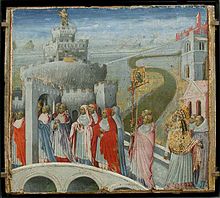Roman Plague of 590

TheRoman Plague of 590was anepidemicofplaguethat affected the city ofRomein the year 590.[1]Probablybubonic plague,it was part of thefirst plague pandemicthat followed the greatplague of Justinian,which began in the 540s and may have killed more than 100 million Europeans[2]before spreading to other parts of the world[3]and which lasted until the end ofLate Antiquity.The plague was described by thebishopandchroniclerGregory of Toursand later chroniclerPaul the Deacon.[1]
History[edit]
The winter before the plague broke out, many of Rome'sgranarieswere damaged when theTiberflooded in November 589. Gregory of Tours recounts thatportentousserpents anddragonswere seen in the waters.[1]The epidemic began in early 590; Gregory's narrative is not specific but death came rapidly to infected patients and the chronicler describes the disease as a 'plague of the groin' (Latin:lues inguinaria), factors which aid its identification as bubonic plague.[1]
Bishop of RomePelagius IIdied of plague in February 590 andPope Gregory I,then adeacon,was elected his successor.[1]Gregory was previouslypraefectus urbibefore becoming amonk.[1]
Gregory had previously served as anapocrisiarius,a kind of papal ambassador to theEast Roman Empire,where he had likely been influenced by Byzantine practices. The imperial capital ofConstantinople,consecrated to the protection of theMother of God(theTheotokos), had a practice whereby processions of the faithful through the city streets chantingpsalmsandkyrie eleisonto allay God's wrath. Gregory had likely witnessed these processions during his stay in Constantinople.[4]
Papal processions[edit]
When the plague was in Rome in 590 and Gregory was still a deacon, he organized such a procession to take place in Rome wherein seven groups would hold processions through the streets of the city and ending at thebasilica of Mary Majorto ask for theVirgin Mary's protection.[4]The processions took place on April 25, 590.[4][5]
The Marian aspect of the procession was perhaps unusual at the time, since Rome was traditionally associated with St Peter's protection, but it may have been a result of Byzantine influence, since Constantinople was often put under the Theotokos's protection during times of crisis.[4]
The seven processional groups were: 1) clergy, 2) abbots and monks, 3) abbesses and nuns, 4) men 5) married women 6) widows and 7) children (also perhaps including the poor of Rome).[4]
The reason for the processions was because plagues and other national disasters were typically interpreted at the time as being the chastisement of God for sinfulness, and therefore to appease God's wrath, these measures were taken.[citation needed]
Eighty people collapsed during the procession as a result of being infected by plague.[1]
Pope Gregory's Vision[edit]

According to later legend, Pope Gregory saw avisionas the procession approached themausoleumof the Roman emperorHadrian,on the right bank of the Tiber near theVatican Hill.[1]The pope beheldSt Michael the Archangelbrandishing and then sheathing his sword atop the monument, which was interpreted to signify that God's wrath had been turned back, and the plague supposedly stopped at that moment, following which the faithful thanked theMother of God.[1][5]
The 2nd century AD imperial tomb, which became a fortress in late Antiquity, subsequently became known asCastel Sant'Angelo,'Castleof the Holy Angel'.[5]In the 18th century, a bronze sculpture was set on the summit of Castel Sant'Angelo to commemorate the legend, portraying the wingedarchangelinRoman armourand designed byPeter Anton von Verschaffeltin 1753.[citation needed]
References[edit]
- ^abcdefghijKohn, George C. (2007) [1995],"Roman Plague of A.D. 590",Encyclopedia of Plague and Pestilence(3rd ed.), Infobase, pp. 323–324,ISBN9781438129235
- ^Frerichs, Ralph R."An Empire's Epidemic".Ph.ucla.edu.Retrieved7 July2018.
- ^"Texas Department of State Health Services, History of Plague".dshs.texas.gov.Archived fromthe originalon 19 June 2016.Retrieved17 January2022.
- ^abcdeAndrew J. Ekonomou.Byzantine Rome and the Greek Popes.Le xing ton Books, 2007,ISBN9780739152751
- ^abc"Plague in Rome".Roman-catholic-saints.Retrieved7 July2018.
